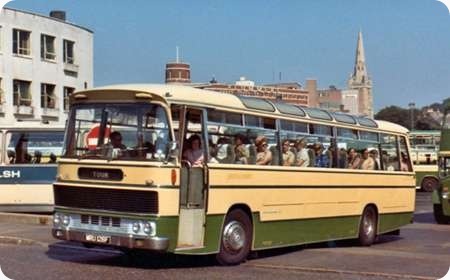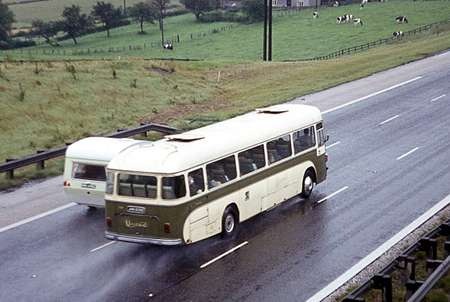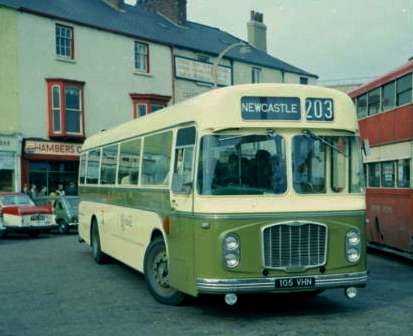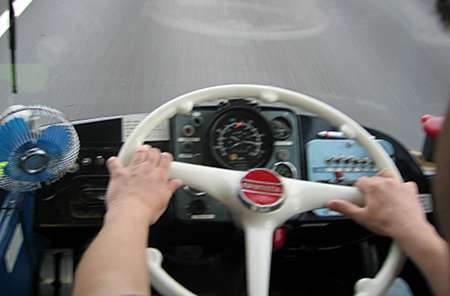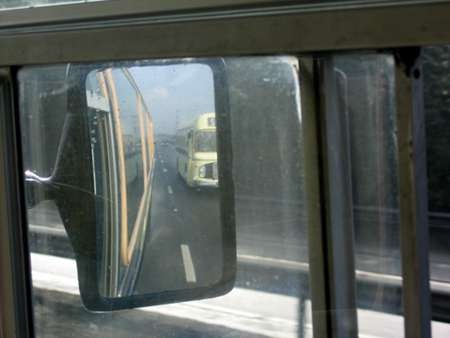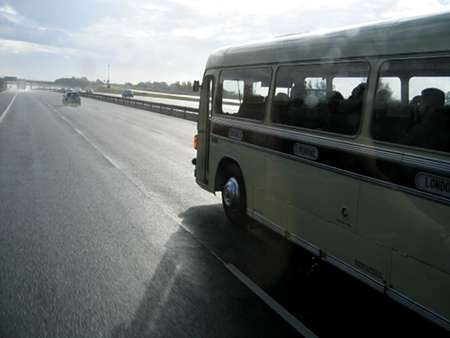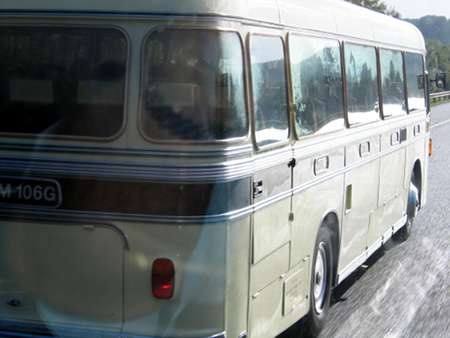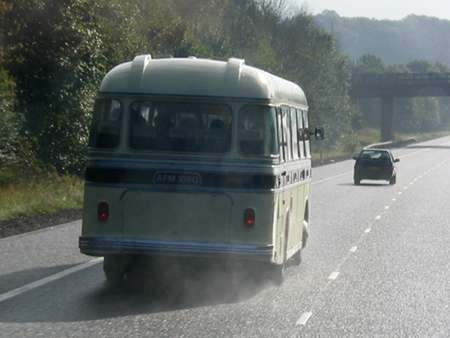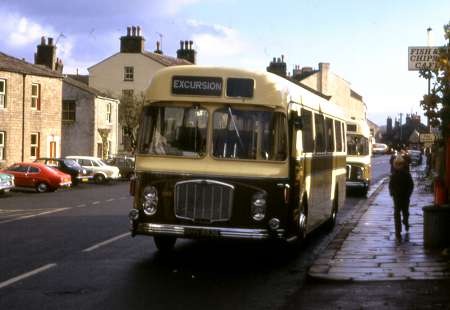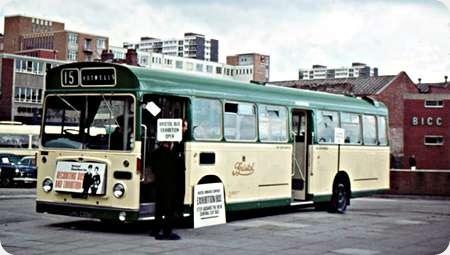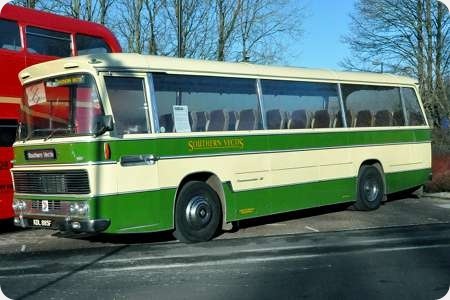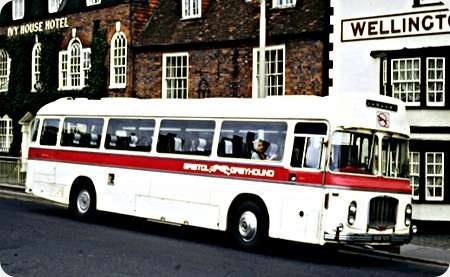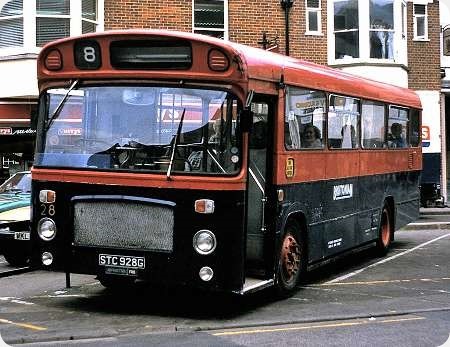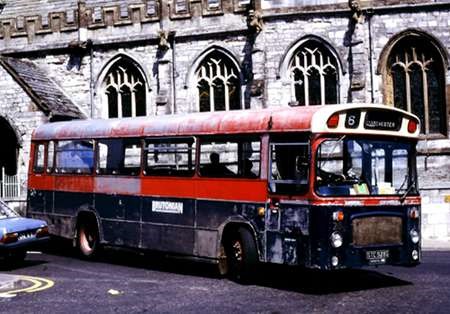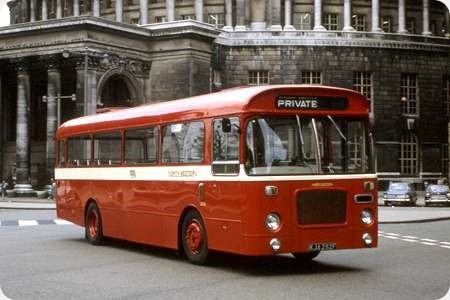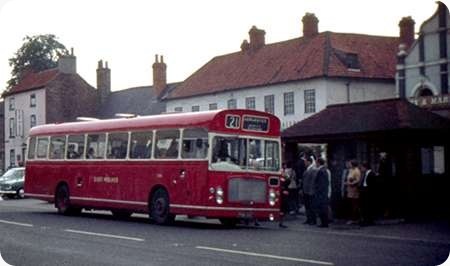
East Midland Motor Services
1968
Bristol RELL6G
ECW B49F
East Midland was an early user of the Bristol RE/ECW combination once they became generally available. This example is seen in Bawtry on 13 July 1968 when it was about three months old.
The rich red livery really suits the vehicle whilst the vertically mounted twin headlamps give a touch of class. How could NBC impose the lacklustre poppy red and leaf green schemes? East Midland even had to change to being a green fleet post 1972. Note the lack of sliding or hopper windows, in common with other BET Companies at this time ventilation is provided by three lift up ventilators in the roof. The only discordant note is the early style shallow windscreens which must have been a real problem to taller drivers.
Photograph and Copy contributed by Ian Wild
26/12/13 – 12:19
These were among the first non-Tilling RE’s that I saw and I remember being very excited at the prospect of Bristols becoming more common, perhaps even in the Manchester area; this did indeed happen, and for a while I was able to travel to work on North Western RE’s.
I drove two or three of Crosville’s “shallow windscreen” RE’s, and beyond the excitement of driving an RE (we were the only Welsh Crosville Depot with no RE buses) I found that the low windscreen top added interest; the top of the windscreen was always in my peripheral vision, but not enough to cause a problem.
Don McKeown
26/12/13 – 14:27
Everyone praises REs. When I was in Widnes and working in a school garden. We had greenhouses about 50 yards from the road.
Every hour a Crossville RE would come past and the greenhouses didn’t half rattle from the exhaust noise of these buses!
Jim Hepburn
26/12/13 – 18:02
In my South Yorkshire/North Derbyshire youth EMMS was a local operator to me. They operated AECs and Leylands – which they then dropped for Bristols. Well I could forgive the Leylands, but not the AECs. Nevertheless, as a student on the X67, travelling from Chesterfield to Manchester (and back) I grew to appreciate the RE more and more and – along with WYRCC on the Yorkshire services to London – to rate it second only to the 6U3ZR Reliance as a premium coach. Many a happy mile was added on visits to Tilling lands across the country – including the X43 from Leeds to Scarborough. …..and then the epic journeys from Manchester to Glasgow or Edinburgh by Ribble and the one off Eastern Scottish ex London RE. I could go on and on – oh sorry, I am doing – but the great joy has been to drive REs late in service life and then in preservation. A real. and deserved, classic. So what did EMMS do? Replaced RELH coaches on the X67 with Nasties – Green Mk I Nationals with slippery bus seats. […..but I bet they wouldn’t have without the strong arm antics from corporate HQ!]
David Oldfield
27/12/13 – 09:46
And they wondered why passengers deserted public transport for cars, David! Nice town, Chesterfield.
Chris Hebbron
27/12/13 – 09:55
Yes, very nice town.
David Oldfield
28/12/13 – 08:03
When TBAT broke up in 1942, certain firms “switched” allegiance. [NBC and BLMC strong arm tactics were nothing new.] Cumberland, United and Lincolnshire were Leyland operators. North Western was a Bristol operator and went from Tilling to BET. It was natural for North Western to take to Bristols with alacrity when they became available in 1965. I do not know the provenance of East Midland, but pre-war they were a Bristol operator and so their renewed allegiance to Bristol should not have come as a surprise. [Their roots were in the local independent, Underwood.] The big surprise – to Leyland Motor Corporation as well – was how readily Ribble and Southdown both took to Bristols. In all the above cases, it was both the RELL and the RELH which were the major swing factors.
David Oldfield
28/12/13 – 10:57
Having re-read my last post, it occurred to me that the bulk of RE buses operated by North Western, Ribble and Southdown were actually RESL – both RESL6G and RESL6L.
David Oldfield
28/12/13 – 13:49
I agree with earlier comments regarding the tasteful shade of red used in this era of East Midland operation. I never did like the corporate NBC colours, especially that awful green, and can only guess how good these would have looked in the EM chocolate, cream and biscuit livery! I spent some time in the old county of Huntingdonshire and frequently travelled between Huntingdon and Saint Ives on United Counties. Often my carriage would be TBD 280G, a dual-purpose RELH6G, new in 1969. This was a most comfortable bus to ride and was in the much better reversed livery of cream and green. Happy days.
Les Dickinson
28/12/13 – 14:44
Here we go again on the subject of livery, who did have the best? Personal taste and where you grew up would have the most influence on your answer. United’s reverse DP livery looked good on most of the single deck fleet, but, although I cant remember any being done this way, I don’t think it would have transferred to double deckers. OK Motor services always looked smart, but probably too time consuming to be practical for a large fleet? For smart plain and simple, you would go a long way to find better examples than Sheffield or Darlington, Midland Red, on the other hand, was in most cases too plain and simple, but few would argue that the all one colour of Glenton was drab or ugly. Bright colours or subdued? The orange and yellow of Yelloway was bright and cheerful, but the black, white and grey of Woods of Blackpool “Seagull Coaches” or the olive green and cream coaches of United were to my mind a classic. Its a question without answer, but it produces some good comments.
Ronnie Hoye
29/12/13 – 14:54
Right now? I’d give anything to go back to the days of NBC/PTE corporate liveries – there was more variety about then than there is now . . . and at least tickets weren’t standardised under NBC. I’ve just finished under-coating the cloak-room wainscot/door, in preparation for a deep blue gloss, and I’ve been struck by the similarity in colour/finish between my undercoat and First’s new livery – OK, I’ll give First a couple of weeks before their colours dull to a matt-like finish. And we don’t even have “proper” local fleet-names anymore, and many of the local-authority operators have disappeared. Anyway, back to the picture . . . wasn’t EMMS red a shade called “BET red”, and common with other companies(?) in the group?
Philip Rushworth
29/12/13 – 17:47
I don’t think that there was a ‘BET’ shade of red. East Midland used a deeper, more maroon shade than nearby Trent, PMT and North Western all of whom seemed to use a slightly different shade of brighter red.
Ian Wild
30/12/13 – 07:10
EMMS red was closer to Ribble than any other BET red. It was stated emphatically that neither was maroon. As Ian says, none of the other three were an identical shade of red. That was the beauty of BET liveries – and of course SUT was unique. In fact the whole set up was unique – and certainly pretty special – since SUT was equally owned by EMMS, Tracky and NWRCC but neither followed the vehicle purchasing nor the operating practises of any of its owners.
David Oldfield
30/12/13 – 11:50
W. T. Underwood was far from being a local independent operator. It was an offshoot of United Automobile Services of Lowestoft. The manager of U.A.S. Mr. E. B. Hutchinson sent one of his ‘bright young men’ W. T. Underwood to Clowne in North Derbyshire in 1920 to establish bus services in the area.
The vehicles were supplied from Lowestoft in the United livery of that time of chrome yellow and brown, later separated with a cream band. The United fleet name was covered over with a board bearing the name of Underwood in the same style.
In 1927 the company was re-named East Midland Motor Services Limited. At this time W. T. Underwood left the company to pursue other interests.
Although United A. S. changed their livery to red around 1930, East Midland retained the old yellow brown and cream livery until 1955. East Midland were under Tilling Group Control until 1942 when control passed to B. E. T.
John Bunting
02/01/14 – 17:29
I wasn’t surprised at BET companies buying Bristol REs as soon as they were available, simply because by that time all the alternative rear-engined single deckers already had questionable reputations, whereas the RE had been giving trouble-free service to Tilling Group operators since before any of them was invented. Unfortunately I wasn’t so keen on RE buses as many enthusiasts, as I’ve never thought much of the interior finish of ECW bus bodies, and I was never in the right place at the right time to sample anything else. Not having to operate or drive them, I much preferred the Leyland Panther.
Coaches of course were a different matter.
Peter Williamson
03/01/14 – 07:59
But Peter, you can’t blame Bristol for the ECW body! Even under common National ownership they were never the same company.
David Oldfield
06/01/14 – 07:57
Although having a big soft spot for the late lamented RE in general, my favourites to ride on were always the Series I, and early Series II models with the shallower windscreen. The RE was designed from the outset with air suspension, which gave a very smooth ride. However, the system did have a few problems relating to short airbag life, especially on stage carriage vehicles, and as a result many operators converted their airbags to coil springs. This fairly straightforward conversion still endowed the RE with a nice ride, but around 1969/70 Bristol’s new masters Leyland decided that the air/coil suspension system would become an optional extra, and that the standard RE would now have traditional leaf springs. Although it could be argued that this simplified the design from an engineering point of view, the result was a rougher-riding RE, which now rattled and banged over uneven road surfaces. This backward step was also said to be the cause of problems relating to increased vibration, movement and cracking around the drop-frame at the front of the chassis. On the ECW bus bodies this led to front domes cracking or working loose, and problems with the flooring and step at the front entrance. The newly introduced BET windscreens also seemed more prone to cracking – surely not a coincidence, as the BET Group had been using the screens successfully for years. Despite these shortcomings, the RE still remained a dependable ‘engineers bus’ to the end, with major units logically laid out for ease of maintenance, repair or removal. There were plans for a Series III RE, which would probably have had improved ‘second generation’ air suspension, and options of more powerful engines. However, as we all know, Leyland had other ideas, and scrapped the RE to give its new integral National a clear field.
Brendan Smith
09/11/14 – 17:01
During the 70s I drove for Royal Blue based at Victoria coach station London. I have fond memories of my time there and in particular driving Bristol REs ECW bodied. I preferred the manual gearbox which could be hard work at times especially on the long routes London to Plymouth or Penzance, the semi automatics did reduce the work load but I felt that I had more control with the manual. I dove most of the routes over the West country and into Dorset, I recall lining up for the tight turn into the down ramp which was Bournemouth coach station. In the later years Leyland joined the fleet with Plaxton bodies but I still preferred the REs in my opinion the finest coach ever to be built. I still think back and recall all my colleagues and I still have copies of the timetable and drivers handbook with route directions which I cherish with much love.
Ernest Goldie
12/01/15 – 07:05
EMMS red was ‘BET Dark Red’ and was the same shade as City of Oxford MS, Northern General and Yorkshire Woollen District. Due to differing paint suppliers the actual shade could vary slightly, even on buses within the same fleet.
Trent, Yorkshire Traction, North Western all used ‘BET Light Red’, again for the above reasons the actual shade could vary slightly.
Midland Red and Ribble both had individual colours not within the BET colour catalogue and referred to by the company name, i.e. ‘Ribble Red’.
Rob F
 Vehicle reminder shot for this posting
Vehicle reminder shot for this posting
09/04/15 – 07:02
If you look at the livery style of East Midland Bristol VR’s that were delivered at the same time you will notice it looks more a Mansfield District style only in red. A company they were about to take over under NBC. Even after privatisation they stayed green.
John Allcock
